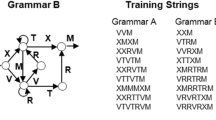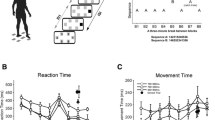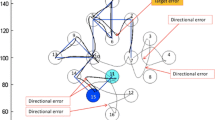Abstract
In three experiments, we examined the effects of age and spatial processing on implicit sequence learning. In experiment 1, 48 older adults (OA) and 48 young adults (YA) performed the alternating serial reaction time task (ASRT) under one of four conditions in which spatial processing demands were either present or absent from stimulus presentation (spatial vs. symbolic cueing) and/or response execution (spatial manual vs. vocal responses). Surprisingly, OA exhibited more learning than YA in the two vocal response conditions. In two follow-up experiments, we increased the response selection demands of the sequence learning task by asking new groups of YA and OA participants to make word categorization responses with 1:1 stimulus–response mapping (experiment 2) and 2:1 mapping (experiment 3) rather than letter reading (vocal response condition of experiment 1). The results showed that YA had increased learning under the more challenging response selection conditions (experiments 2 and 3) while OA did not. We propose that (1) manipulating the spatial aspects of implicit sequence learning does not necessarily impact the amount of learning for OA, (2) implicit sequence learning depends on both the structure of response execution and relative task difficulty, and (3) these factors affect implicit sequence learning for both YA and OA.







Similar content being viewed by others
References
Bennett IJ, Howard JH Jr, Howard DV (2007) Age-related differences in implicit learning of subtle third-order sequential structure. J Gerontol B Psychol Sci Soc Sci 62:98–103
Carretti B, Borella E, De Beni R (2007) Does strategic memory training improve the working memory performance of younger and older adults? Exp Psychol 54:311–320
Cherry KE, Stadler MA (1995) Implicit learning of a nonverbal sequence in younger and older adults. Psychol Aging 10:379–394
Cohen A, Ivry RI, Keele SW (1990) Attention and structure in sequence learning. J Exp Psychol Learn Mem Cogn 16:17–30
Craik FIM, Byrd M (1982) Aging and cognitive deficits: the role of attentional resources. In: Craik FIM, Trehub S (eds) Aging and cognitive processes. Plenum, New York, pp 191–211
Curran T (1997) Effects of aging on implicit sequence learning: accounting for sequence structure and explicit knowledge. Psychol Res Psychologische Forschung 60:24–41
Daneman M, Carpenter PA (1980) Individual-differences in working memory and reading. J Verbal Learn Verbal Behav 19:450–466
Dennis NA, Howard JH, Howard DV (2003) Age deficits in learning sequences of spoken words. J Gerontol B Psychol Sci Soc Sci 58:224–227
Dennis NA, Howard JH Jr, Howard DV (2006) Implicit sequence learning without motor sequencing in young and old adults. Exp Brain Res 175:153–164
Etnier JL, Salazar W, Landers DM, Petruzzello SJ, Han M, Nowell P (1997) The influence of physical fitness and exercise upon cognitive functioning: a meta-analysis. J Sport Exerc Psychol 19:249–277
Etnier JL, Romero DH, Traustadottir T (2001) Acquisition and retention of motor skills as a function of age and aerobic fitness. J Aging Phys Act 9:425–437
Feeney JJ, Howard JH, Howard DV (2002) Implicit learning of higher order sequences in middle age. Psychol Aging 17:351–355
Folstein MF, Folstein SE, Mchugh PR (1975) Mini-mental state—practical method for grading cognitive state of patients for clinician. J Psychiatr Res 12:189–198
Frensch PA, Miner CS (1994) Effects of presentation rate and individual-differences in short-term-memory capacity on an indirect measure of serial-learning. Mem Cogn 22:95–110
Goschke T, Friederici AD, Kotz SA, van Kampen A (2001) Procedural learning in Broca’s aphasia: dissociation between the implicit acquisition of spatio-motor and phoneme sequences. J Cogn Neurosci 13:370–388
Guadagnoli MA, Lee TD (2004) Challenge point: a framework for conceptualizing the effects of various practice conditions in motor learning. J Mot Behav 36:212–224
Hartman M, Knopman DS, Nissen MJ (1989) Implicit learning of new verbal associations. J Exp Psychol Learn Mem Cogn 15:1070–1082
Heuninckx S, Wenderoth N, Swinnen SP (2008) Systems neuroplasticity in the aging brain: recruiting additional neural resources for successful motor performance in elderly persons. J Neurosci 28:91–99
Howard DV, Howard JH (1989) Age-differences in learning serial patterns—direct versus indirect measures. Psychol Aging 4:357–364
Howard DV, Howard JH Jr, Japikse K, DiYanni C, Thompson A, Somberg R (2004a) Implicit sequence learning: effects of level of structure, adult age, and extended practice. Psychol Aging 19:79–92
Howard JH, Howard DV, Dennis NA, Yankovich H, Vaidya CJ (2004b) Implicit spatial contextual learning in healthy aging. Neuropsychology 18:124–134
Huxhold O, Li SC, Schmiedek F, Lindenberger U (2006) Dual-tasking postural control: aging and the effects of cognitive demand in conjunction with focus of attention. Brain Res Bull 69:294–305
Jones DNC, Barnes JC, Kirkby DL, Higgins GA (1995) Age-associated impairments in a test of attention—evidence for involvement of cholinergic systems. J Neurosci 15:7282–7292
Kessels RP, van Zandvoort MJ, Postma A, Kappelle LJ, de Haan EH (2000) The Corsi block-tapping task: standardization and normative data. Appl Neuropsychol 7:252–258
Koch I, Hoffmann J (2000) The role of stimulus-based and response-based spatial information in sequence learning. J Exp Psychol Learn Mem Cogn 26:863–882
Lindenberger U, Marsiske M, Baltes PB (2000) Memorizing while walking: increase in dual-task costs from young adulthood to old age. Psychol Aging 15:417–436
Lustig C, Meck WH (2001) Paying attention to time as one gets older. Psychol Sci 12:478–484
Mattis S (1988) Dementia rating scale. Psychological Assessment Resources, Inc, Odessa
Miyawaki K (2006) The influence of the response-stimulus interval on implicit and explicit learning of stimulus sequence. Psychol Res Psychologische Forschung 70:262–272
Nattkemper D, Prinz W (1997) Stimulus and response anticipation in a serial reaction task. Psychol Res Psychologische Forschung 60:98–112
Negash S, Howard DV, Japikse KC, Howard JH (2003) Age-related differences in implicit learning of non-spatial sequential patterns. Aging Neuropsychol Cogn 10:108–121
Nissen MJ, Bullemer P (1987) Attentional requirements of learning: evidence from performance measures. Cogn Psychol 19:1–32
Oldfield RC (1971) Assessment and analysis of handedness—Edinburgh inventory. Neuropsychologia 9:97
Owsley C, Burton-Danner K, Jackson GR (2000) Aging and spatial localization during feature search. Gerontology 46:300–305
Parasuraman R, Giambra L (1991) Skill development in vigilance—effects of event rate and age. Psychol Aging 6:155–169
Parkin AJ, Walter BM (1991) Aging, short-term-memory, and frontal dysfunction. Psychobiology 19:175–179
Puglisi JT (1980) Semantic encoding in older adults as evidenced by release from proactive-inhibition. J Gerontol 35:743–745
Reber AS (1993) Implicit learning and tacit knowledge: an essay on the cognitive unconscious. Oxford University Press, New York
Reuter-Lorenz PA, Jonides J, Smith EE, Hartley A, Miller A, Marshuetz C, Koeppe RA (2000) Age differences in the frontal lateralization of verbal and spatial working memory revealed by PET. J Cogn Neurosci 12:174–187
Salthouse TA, Miles JD (2002) Aging and time-sharing aspects of executive control. Mem Cogn 30:572–582
Spencer RM, Gouw AM, Ivry RB (2007) Age-related decline of sleep-dependent consolidation. Learn Mem 14:480–484
Stewart AL, Mills KM, King AC, Haskell WL, Gillis D, Ritter PL (2001) CHAMPS physical activity questionnaire for older adults: outcomes for interventions. Med Sci Sports Exerc 33:1126–1141
Thurston LL (1951) An analysis of mechanical aptitude. University of Chicago, Psychometric Lab, Chicago
Wechsler D (1981) Wechsler adult intelligence scale revised. Psychological Corporation, New York
Willingham DB, Wells LA, Farrell JM, Stemwedel ME (2000) Implicit motor sequence learning is represented in response locations. Mem Cogn 28:366–375
Wilson BA, Alderman N, Burgess PW, Emslie HE, Evans JJ (1996) Behavioural assessment of the dysexecutive syndrome. Thames Valley Test Company, Bury St. Edmunds
Acknowledgments
This work was supported by NIH AG024106 (to RS) and the UM Pepper Center Human Subjects Core (NIH AG 08808). The authors wish to thank all of the research assistants who helped with data collection and the participants who gave willingly of their time and effort. We also thank Dr. D. Willingham for helpful discussion of this work.
Author information
Authors and Affiliations
Corresponding author
Rights and permissions
About this article
Cite this article
Bo, J., Seidler, R.D. Spatial and symbolic implicit sequence learning in young and older adults. Exp Brain Res 201, 837–851 (2010). https://doi.org/10.1007/s00221-009-2098-5
Received:
Accepted:
Published:
Issue Date:
DOI: https://doi.org/10.1007/s00221-009-2098-5




